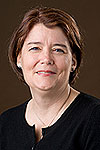Thank you
Patricia McBride, head of the CMS Center, wrote this column.
 |
|
Patricia McBride
|
The last few weeks have been an exciting time for particle physics. The CMS community around the world shared in the historic July 4 announcement of the discovery of a new particle. The observation of this Higgs-like resonance had long been anticipated, perhaps even expected by some. Still, the announcement, part of the opening session of the International Conference on High Energy Physics in Melbourne, Australia, was received with much elation. We were delighted to share the broadcast from CERN with our colleagues, friends and family as we gathered for a viewing party at Fermilab at 2 a.m.
Many of the scientists and postdocs at the LHC Physics Center (LPC) at Fermilab have been directly involved in the Higgs search analyses. At the all-hands meeting on July 5, we had the opportunity to join our colleagues from the Tevatron experiments to share some ruminations on the Higgs with the rest of the Fermilab community. Volunteers wore "Ask me about the Higgs" badges and answered questions after the meeting.
We have many people to thank for their efforts to make CMS succeed in its hunt for the Higgs particle. Many people at the laboratory have contributed to the experiment and the collaboration over nearly two decades. Fermilab's Dan Green has been one of the leaders. He formed the Fermilab CMS group in the 1990s, worked closely with the funding agencies and shaped the US participation in the planning, construction and operation of the CMS experiment. At a special colloquium last week, he gave highlights of a long career at the Energy Frontier and his observations about the hunt for the Higgs.
The Fermilab Tier-1 CMS computing facility under the leadership of Lothar Bauerdick, Jon Bakken and Burt Holtzman has been a major success. The facility, coupled with the LPC CMS Analysis Facility, has allowed CMS scientists to process and analyze the 2012 datasets collected this spring in a prompt and timely matter. In addition, the software experts at the lab have made our software flexible, fast and manageable. Many thanks to the many members of the software team, the computing operations team and the whole Tier-1 team who all have made invaluable contributions to the success of the collaboration.
The CMS community sends a big thank you to the Fermilab staff who contributed to the construction and operation of the CMS detector and to the LARP collaboration and our colleagues in the Accelerator Division and Technical Division who worked on the LHC magnets and the commissioning of the LHC accelerator. It took a large and extremely dedicated team to make this global scientific endeavor a success, and Fermilab has been a proud partner in this journey.
We look forward to taking the next steps and exploring the properties of this Higgs-like particle. Perhaps we will find some new, unexpected physics in the not too distant future.
|